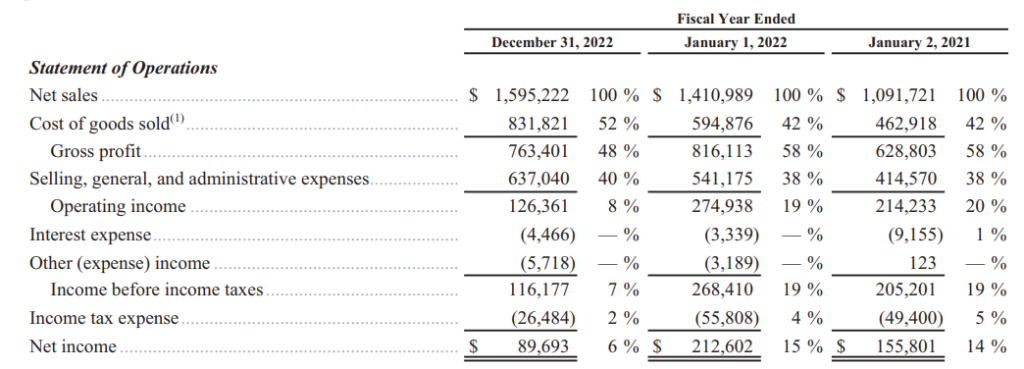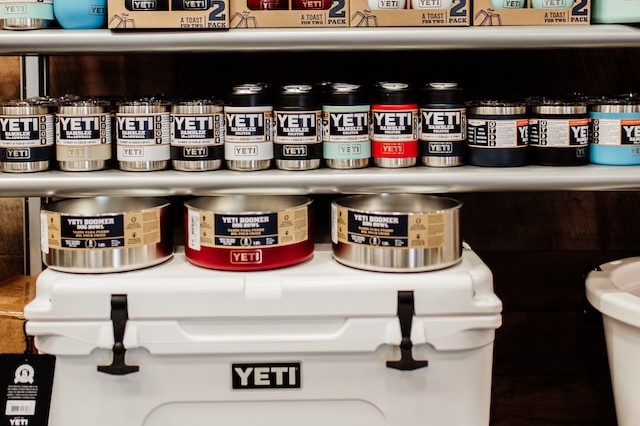Before we dive deep into the SWOT analysis, let’s get the business overview of Yeti. Yeti Inc. is a leading manufacturer and retailer of high-quality outdoor lifestyle products, which include coolers, drinkware, bags, and other outdoor accessories.
Founded in 2006 by brothers Roy and Ryan Seiders, the company was built to create durable, high-performance gear to cater to the needs of outdoor enthusiasts, hunters, fishermen, and adventurers.
Product Lines:
- Coolers: Yeti’s flagship products are their premium coolers, which include hard coolers (Tundra Series), soft coolers (Hopper Series), and backpack coolers. Known for their exceptional insulation, rugged design, and long-lasting performance, these coolers are popular among customers seeking high-quality outdoor cooling solutions.
- Drinkware: Yeti offers a wide range of insulated drinkware, including tumblers, bottles, mugs, and jugs. These products are made from stainless steel with vacuum insulation, which helps maintain the temperature of beverages for extended periods.
- Bags: Yeti provides a variety of durable, waterproof bags and backpacks suitable for outdoor adventures, such as duffel bags, waterproof backpacks, and insulated lunch bags.
- Outdoor Gear: The company also offers an assortment of outdoor gear and accessories, like chairs, blankets, dog bowls, and more. These products cater to the diverse needs of outdoor enthusiasts and help enhance their experiences in the wild.
Business Model: Yeti operates through a multi-channel distribution model, which includes direct-to-consumer sales through its e-commerce platform and a network of authorized retailers. By focusing on premium materials, innovative designs, and exceptional customer service, Yeti has carved out a niche in the outdoor products market.
Market Positioning: Yeti has established itself as a premium brand in the outdoor products market, attracting customers who value quality, durability, and performance. With an emphasis on innovation and continuous improvement, Yeti has maintained a loyal customer base and differentiated itself from competitors.
Key Growth Strategies:
- Product Innovation: Yeti continuously invests in research and development to improve existing and launch new products, ensuring it stays ahead of the curve in the rapidly evolving outdoor products market.
- Geographic Expansion: By entering new markets and expanding its distribution network, Yeti aims to capitalize on the growing demand for premium outdoor products worldwide.
- Marketing and Brand Awareness: Yeti continues to build brand awareness through targeted marketing campaigns, collaborations, and partnerships with outdoor enthusiasts, influencers, and ambassadors.
- Net sales in 2022 increased by 13% to $1.6 billion.
- Gross profit in 2022 decreased by 6% to $763 million.

Here is the SWOT analysis for Yeti
A SWOT analysis is a strategic planning tool used to evaluate the Strengths, Weaknesses, Opportunities, and Threats of a business, project, or individual. It involves identifying the internal and external factors that can affect a venture’s success or failure and analyzing them to develop a strategic plan. In this article, we do a SWOT Analysis of Yeti.
SWOT Analysis: Meaning, Importance, and Examples
Strengths
- Strong Brand Reputation: Yeti has established itself as a premium brand in the outdoor products market, synonymous with quality, durability, and performance. This strong brand reputation attracts loyal customers who pay a premium for high-quality products.
- High-Quality Products: Yeti’s commitment to using premium materials and innovative designs results in high-quality products with superior performance and longevity. This sets Yeti apart from competitors and ensures customer satisfaction.
- Product Innovation: Yeti’s focus on research and development enables the company to introduce new and improved products regularly, catering to the evolving needs of outdoor enthusiasts. This commitment to innovation helps maintain customer interest and brand loyalty.
- Diversified Product Portfolio: Yeti offers a wide range of outdoor products, including coolers, drinkware, bags, and other accessories. This diversified portfolio caters to different customer needs and helps mitigate risks depending on a single product category.
- Multi-Channel Distribution: Yeti’s multi-channel distribution strategy, which includes direct-to-consumer sales through its e-commerce platform and a network of authorized retailers, ensures broad market reach and helps the company reach more customers.
- Loyal Customer Base: Yeti’s focus on customer satisfaction, exceptional product quality, and after-sales service has helped build a loyal customer base that contributes to repeat purchases and word-of-mouth marketing.
- Strategic Partnerships and Collaborations: Yeti’s partnerships with outdoor enthusiasts, influencers, and ambassadors help increase brand visibility and strengthen its market positioning as a premium outdoor lifestyle brand.
- Scalable Business Model: Yeti’s business model allows for scalability, enabling the company to expand its product offerings, enter new markets, and grow its distribution network without significant challenges.
Weaknesses
- Premium Pricing: Yeti’s high-quality products come with premium price tags, which may deter price-sensitive customers and limit the brand’s appeal to a specific market segment. This could result in limited market share compared to more affordably priced competitors.
- Competition: The outdoor products market is highly competitive, with numerous brands offering similar products. Yeti faces competition from both established players and new entrants, which may affect market share and profitability.
- Dependence on Third-Party Manufacturers: Yeti relies on third-party manufacturers for the production of its products. This dependence can pose risks such as supply chain disruptions, quality control issues, or increased production costs that may impact the business.
- Limited International Presence: Although Yeti has started to expand internationally, its presence in global markets is still limited compared to other major outdoor product brands. This may restrict growth opportunities and make the company more vulnerable to regional market fluctuations.
- Counterfeit Products: The popularity of Yeti’s products has led to the proliferation of counterfeit and imitation products in the market. This erodes brand value and can lead to customer dissatisfaction and potential legal issues.
- Potential Environmental Concerns: Manufacturing outdoor products, especially those made of plastic and metal materials, can have environmental implications. Increased scrutiny of environmental practices and potential regulatory changes could impact Yeti’s production costs or require changes in its manufacturing processes.
- Slow Adoption of New Products: Yeti’s premium pricing and the durability of its products may result in customers taking longer to adopt new offerings. This slow adoption rate can limit the company’s ability to capitalize quickly on new product launches and innovations.
- Economic Sensitivity: As a premium brand, Yeti’s sales may be more susceptible to economic downturns when customers may cut back on discretionary spending. This sensitivity to economic conditions can lead to fluctuations in revenue and profitability.
Opportunities
- Geographic Expansion: Yeti can capitalize on the growing demand for premium outdoor products by expanding its presence in emerging markets and untapped regions. This would increase its customer base, diversify revenue streams, and reduce dependence on existing markets.
- Product Line Expansion: By introducing new products and expanding into adjacent categories, such as camping equipment, outdoor apparel, or footwear, Yeti can cater to a broader range of customer needs and tap into new revenue streams.
- Collaboration and Partnerships: Yeti can explore strategic partnerships with other outdoor brands, retailers, or organizations to enhance its product offerings, increase brand visibility, and access new distribution channels.
- Sustainability Initiatives: By focusing on sustainable materials and production processes, Yeti can appeal to environmentally conscious consumers and strengthen its brand image. This includes implementing eco-friendly packaging, utilizing recycled materials, and promoting responsible disposal practices.
- Targeting New Customer Segments: Yeti can explore opportunities to target new customer segments, such as younger consumers, urban dwellers, and casual outdoor enthusiasts, with tailored marketing campaigns and product offerings.
- Enhancing Digital Presence: Investing in digital marketing, e-commerce capabilities, and leveraging social media platforms can help Yeti strengthen its online presence and improve customer engagement, increasing sales and brand awareness.
- Technological Innovations: Yeti can invest in cutting-edge technology to develop advanced, energy-efficient cooling systems, insulation materials, or smart features in its products, giving it a competitive advantage and reinforcing its position as an innovative brand in the outdoor products market.
- Acquisition and Mergers: Yeti can explore opportunities to acquire or merge with complementary businesses, which can help expand its product portfolio, improve distribution networks, and enhance its market presence.
Threats
- Intense Competition: The outdoor products market is highly competitive, with numerous brands offering similar products at varying prices. Yeti faces competition from both established players and new entrants, which could lead to pricing pressures, loss of market share, and reduced profitability.
- Economic Fluctuations: As a premium brand, Yeti’s sales may be susceptible to economic downturns when customers may cut back on discretionary spending. Economic fluctuations can reduce consumer demand and impact the company’s revenue and profitability.
- Supply Chain Disruptions: Yeti relies on third-party manufacturers to produce its products, making it vulnerable to supply chain disruptions caused by natural disasters, geopolitical tensions, or other unforeseen events. Such disturbances can lead to delays in product delivery, increased costs, and potential damage to the brand’s reputation.
- Counterfeit Products: The popularity of Yeti’s products has led to the proliferation of counterfeit and imitation products in the market. These counterfeit products erode brand value and result in customer dissatisfaction and potential legal issues.
- Changing Consumer Preferences: The outdoor products market constantly evolves, and consumer preferences can shift rapidly. Failure to anticipate and adapt to these changes in consumer preferences can lead to decreased demand for Yeti’s products and impact its market position.
- Regulatory Changes: Changes in environmental, labor, or trade regulations in the countries where Yeti operates or sources its products can lead to increased compliance costs, production challenges, or disruptions in its supply chain.
- Currency Fluctuations: As Yeti expands its international presence, it becomes more exposed to fluctuations in foreign currency exchange rates. Volatile currency movements can impact the company’s financial performance and profitability.
- Technological Disruptions: Rapid technological advancements and innovations in the outdoor products market may result in the developing of new materials or products that can outperform Yeti’s offerings. Failure to stay ahead of technological changes can make the company’s products obsolete or less competitive.









